Salesforce DevOps Center: Dive Deeper in 2026 Guide
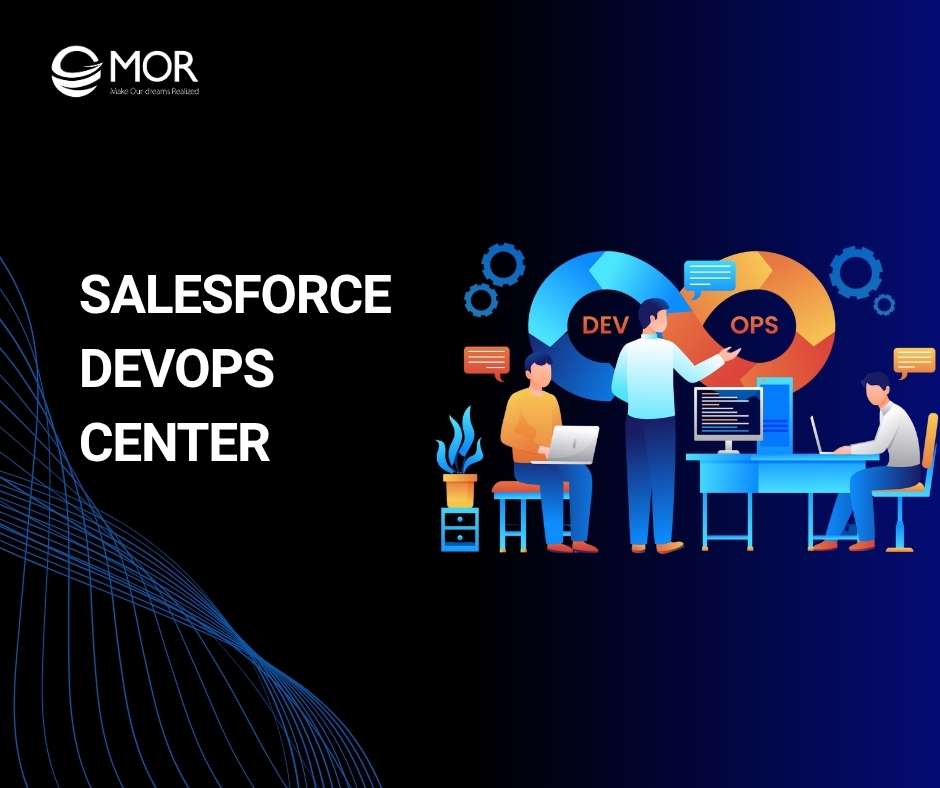
The Salesforce DevOps Center is now a core topic for teams that struggle with slow releases, risky deployments, and hard to manage change sets. Many businesses want a setup that feels cleaner, safer, and easier to control. This guide from MOR Software will introduce the platform in a clear and practical way so you can see how it solves these real problems.
What Is Salesforce DevOps Center?
The Salesforce DevOps Center brings low code or no code builders and pro code developers into one shared space. It lets both groups work with the same configuration and code while following best practices DevOps in a simple and clear way. At a time when Gartner estimates that by 2025 about 70% of new applications will use low code or no code technologies, up from less than 25% in 2020. This setup strengthens teamwork and helps every role stay connected, including admins, developers, release owners, QA teams, and business partners.
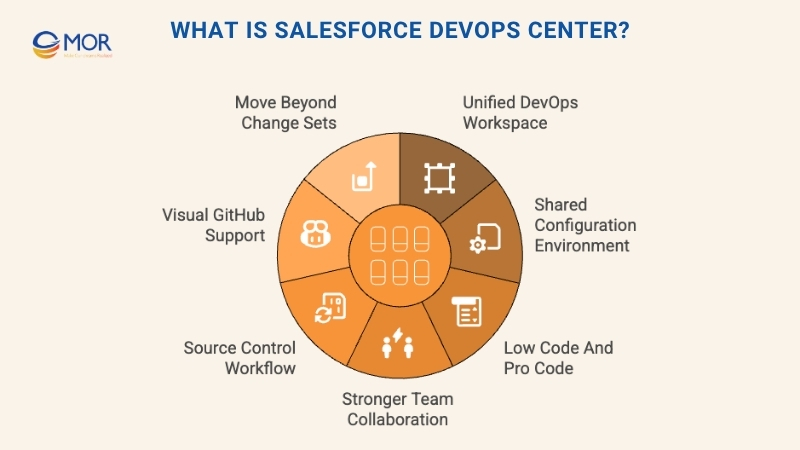
“DevOps Center focuses on change and release work, and it brings DevOps habits to everyone in our community, no matter where they stand on the low code or pro code path” said Karen Fidelak, Product Manager for Salesforce and DevOps.
The purpose of the DevOps for Salesforce is to move strong habits like source control into the normal deployment method.
Pro code developers have used the command line and simple scripts for a long time to send changes to tools like GitHub.
The system gives admins similar strength, while keeping the hard parts of GitHub inside a clean and easy visual interface.
Your daily work may look different if you build directly in production or rely on change sets to move metadata between sandboxes and production. Still, the advantages of using this setup are hard to ignore.
Goodbye to manual change sets. The DevOps Center takes the place of Salesforce change sets. Many teams agree that change sets feel slow, confusing, and tiring to use. One Rabobank DevOps case study showed that time spent on deployments dropped by about 60% after the bank moved from manual release steps to an automated application release system.
People often turn to custom scripts, paid DevOps tools, or direct work in Production when they want something faster or safer.
“This will make my work so much easier” said one admin after learning that DevOps for Salesforce would be open for public beta.
Salesforce DevOps Center Release And Availability
The Salesforce DevOps Center launch marks an important step for many teams. An IDC survey of Fortune 1000 companies found that 43% were already using DevOps practices and another 40% were actively evaluating them. People have waited a long time for it because the platform has spent more than two years in active development, starting with early pilot users and then moving to a broader closed beta group. The feedback from these users helped shape the plan for future updates.

Salesforce must find a middle point between giving customers a wide range of features and getting the first release ready for General Availability. The team set the GA target for December 9th, 2022.
Since the best Salesforce DevOps Center tools come as a Managed Package, it does not depend on the three scheduled platform updates each year. This setup gives the team more freedom to release improvements, especially for people who rely on deployment tools in Salesforce for daily development work.
Key Benefits Of Salesforce DevOps Center
Here is a simple look at what the Salesforce DevOps Center can do right now.
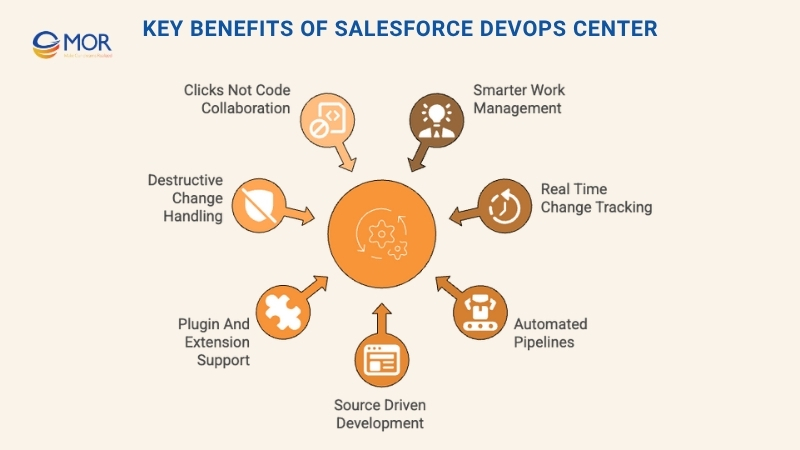
Smarter Work Management
A clear and structured flow that uses user stories, work items, and DevOps pipelines helps teams understand what changes must be delivered. Everyone can work together, stay organized, and keep their focus on shared goals.
Real-Time Change Tracking
Teams can track updates automatically through Git inside the Salesforce DevOps tools. A version control system gives full visibility into every change and shows who made each update. This approach lowers the chance of overwriting work and helps teams find conflicts early, which leads to a safer and more open process.
Automated Pipelines
Teams can set up pipelines inside DevOps and Salesforce to view how changes move across each environment. This setup allows automatic checks at every step, which lowers the amount of manual work for teammates and helps catch bugs and errors much earlier in the development flow.
Source-Driven Development
The strong GitHub connection in the DevOps Center helps more Salesforce teams work with source driven habits. Version control becomes the trusted record of all updates, letting teams keep a full change history, apply branching methods that fit their salesforce workflow, and support smooth teamwork across different projects.
Plugin And Extension Support
The Salesforce DevOps Center does not include every advanced DevOps feature at the start, but teams can add extension packages to move toward a stronger development process. For example, the Provar DevOps Center Plugin on the AppExchange brings testing into the release flow for Provar Manager users, which helps improve the stability of each deployment.
Handling Destructive Changes
The Center lets teams apply destructive changes across environments, which is a clear improvement over change sets. Still, it does not include a rollback option for these actions. If you want to undo a destructive update, you must reverse the change inside source control and send it again to the right environment through the Salesforce DevOps engineer. This method requires several manual steps and also increases the chances of human mistakes.
TechTarget estimated that downtime can cost organizations an average of about $9,000 per minute or $540,000 per hour. Therefore, a single bad destructive change can become very expensive if it reaches production.
Clicks-Not-Code Collaboration
The system may not have the most polished interface, yet it supports the simple idea of working with clicks instead of code. This approach makes the platform friendly for admins and low code builders who want to take part in the release cycle. It also helps remove barriers inside the team and encourages smoother teamwork between people with technical skills and those who rely more on visual tools.
>>> Finding the right salesforce commerce cloud consultant can be the difference between a successful digital commerce strategy and a costly misstep. Let's find out!
How To Get Started With Salesforce DevOps Center?
Installing the Salesforce DevOps Center managed package is simple. You can open Setup and enter “devops” into the Quick Find box. The full setup steps, including how to connect and configure GitHub, are listed in the Implementation Guide, which you can download from the link provided in the original source.
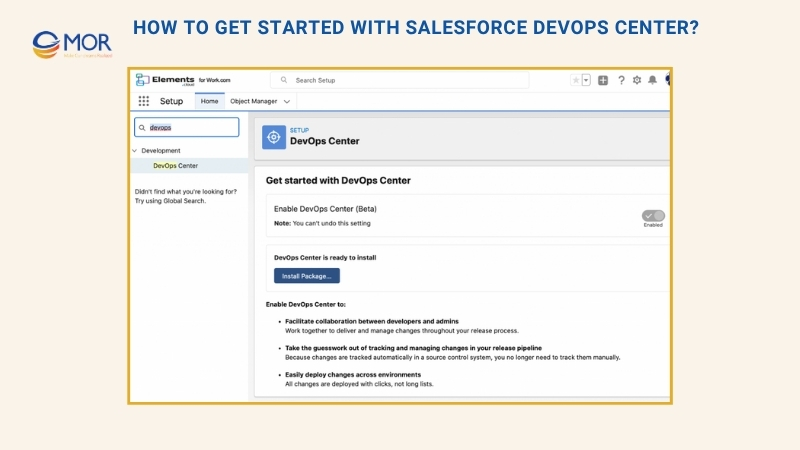
The first release works with the Lightning platform, and the system is designed to let partners build extra extension packages that expand its functions.
The long term direction for the deployment tools in Salesforce is to create one shared deployment method for different Salesforce products. This includes Lightning, Heroku, Mulesoft, Commerce, Marketing, and many third party solutions that connect with the ecosystem.
How Does Salesforce DevOps Center Work?
Before looking at the full flow, it helps to understand the main parts inside the Salesforce DevOps Center and how they connect to each other.
- Release Management: A group of changes is placed into a release. Each release is divided into one or more user stories.
- User Story Creation: These are created during business analysis with support from end users. Each user story is linked to one or more work items.
- Managing Work Items: These items include the metadata that needs to be changed. You prepare this list once, unlike change sets that must be rebuilt every time you move changes between orgs. A work item moves through the pipeline from development to production.
- Pipelines And Staging Projects: These show the order of orgs that a work item goes through as it moves from development to production. You can set up separate pipelines, such as “core” or “hotfix”.
- Bundled Promotion Stages: You can mark one or more stages as bundled. When this happens, all work items in that stage move together to the next step.
- GitHub Integration For Version Control: The platform handles all GitHub branches quietly behind the scenes, including the movement of metadata between branches and Salesforce orgs. GitHub is the only supported source control system at this time.
Below is a data model that shows how these parts relate during Business Analysis work and the later Development work, especially when compared to change sets.

Release Management
All metadata updates go into a release, no matter the size. This applies to the very first release of a new app in a Salesforce org, which may include hundreds of metadata items, and it also applies to a small hotfix that may contain only one or two items.
Releases are prepared and managed outside the Salesforce DevOps Center, and they are built based on business needs. Each release contains one or more user stories that describe the required changes.
User Story Creation
A user story describes the full scope of the work that needs to be done. It includes more than the metadata that will be added or updated. It also holds all information gathered during business analysis so developers can complete the work smoothly and with fewer mistakes. This extra detail gives clear context and helps prevent rework that happens when teams misunderstand requirements.
A user story may include:
- The release it belongs to.
- Notes and written instructions.
- Links to videos or shared documents.
- Images, wireframes, diagrams, or whiteboard photos.
- Business process maps, capability charts, and flowcharts.
- ERDs or Entity Relationship Diagrams.
- Salesforce integration architecture diagrams.
- Details about the roles affected.
- Technical, business, and compliance risk details.
- A link to the Jira ticket if Jira is used for task tracking.
User stories are also created and handled outside the app.
Managing Work Items
Inside the Salesforce DevOps Center, a work item acts like a user story and holds the full list of metadata that will move through the pipeline.
A single user story can create and connect to one or more work items. In most cases, it links to only one, but if a fix is needed for the metadata in that work item, a new one must be created because the original work item cannot be reopened.
You can only see the link between these work items inside the user story, as the setup itself does not show this relationship.
In the past, teams had to build a new change set and add metadata items again every time they moved changes between orgs. One change set would be used to move updates from Dev to UAT, and another would be required to move the same updates from UAT to Production. There was no simple way to copy a full list of metadata, which made change sets slow and frustrating for many people.
“With change sets, you feel lucky if it works on the first try. With the Salesforce DevOps Center, you feel let down if it doesn’t.” – John Eichsteadt, Platform Owner, Marcus & Millichap
A change set can also include hundreds of metadata items because it often represents a full release. With the tool, you can use several work items inside one release, which allows you to split that release into smaller and easier pieces.
When a work item is created from a user story, you link it to a Salesforce org. Behind the scenes, the Salesforce DevOps builds a GitHub branch for that work item.
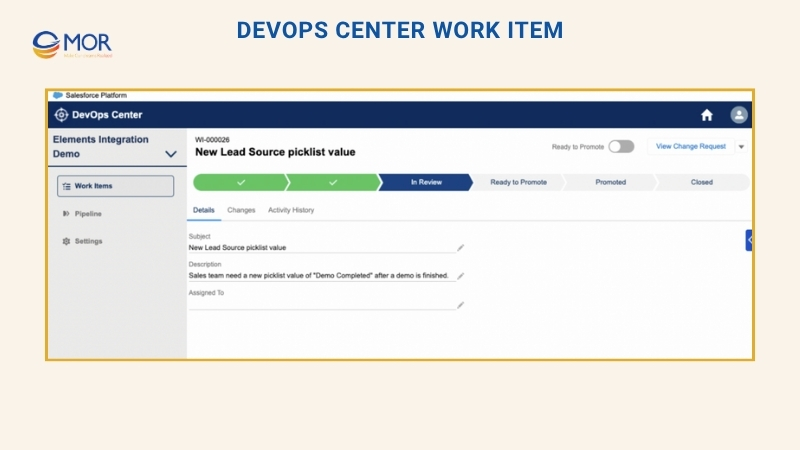
You can then view all the metadata changes in that org and choose which ones you want to add to the work item. This flow is far faster than creating a change set and adding metadata one item at a time.
You only complete this step once because the work item is what moves through the pipeline. It gives you a simple, clean way to build a work item and is one of the main reasons many teams see the switch to the system as an easy decision.
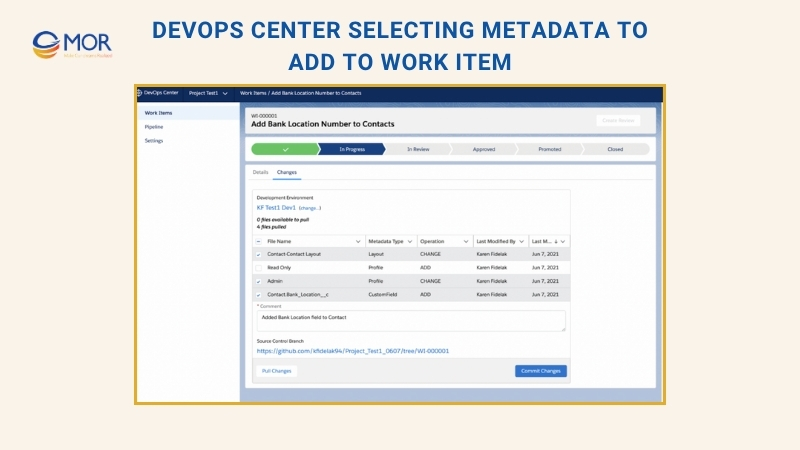
Pipelines And Staging Projects
Pipelines show the full salesforce developer career growth that work items follow as they move from development to production.
Each pipeline includes a set of stages, and every stage connects to a specific Salesforce org. A stage may point to a scratch org or a sandbox for building features. Another stage might be used for UAT or staging, and the final one leads to production. A work item is “promoted” from one stage to the next as it progresses through the pipeline.
The Salesforce DevOps Center lets you create several pipelines, each inside its own project. For example, a team may use four pipelines named High, Medium, Low, and Hot Fix. This setup helps match the right amount of development and testing effort to the level of risk. If a change carries low risk, it can reach production faster and with lower cost. The team can measure risk by checking metadata, dependencies, and the business processes linked to those changes.
DevOps Center Pipeline with Work Items in each Stage in Project “Elements Integration Demo”
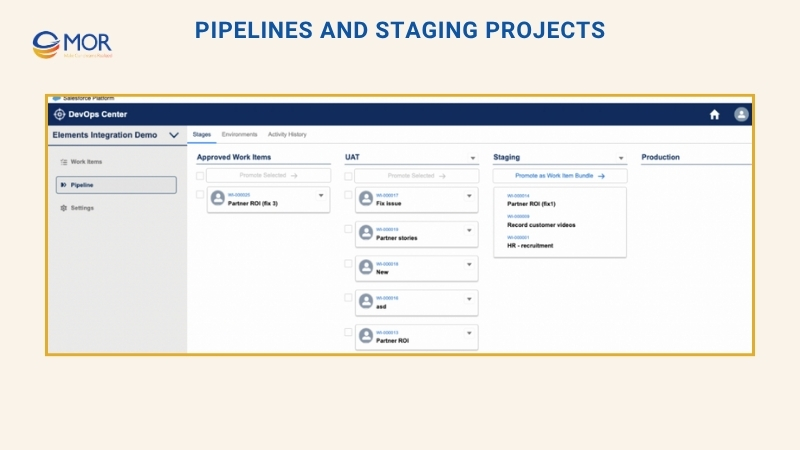
Bundled Promotion Stages
You can set any stage in a pipeline as a “bundled” stage. When you promote one work item from that stage, every other work item sitting in the same stage will move forward at the same time.
If that stage is also marked as “bundled” in other pipelines, then all work items in that stage across all pipelines will be promoted together. Teams should plan their pipeline design carefully. A simple starting point is to keep one core pipeline and one hotfix pipeline to avoid unwanted promotions.
GitHub Integration For Version Control
Inside the Salesforce DevOps Center, the system quietly manages every GitHub branch, including how metadata moves between branches and between Salesforce orgs.
GitHub is the main source control system supported. Still, admins do not need to learn GitHub or the CLI because the app handles the complex parts for them. Source control may feel like a big shift for many admins, but the platform hides most of the difficult steps.
Developers who use CLI commands for GitHub only need to make a small update to the command they use to commit changes. This lets the system track those updates correctly. This step matters because all configuration and code updates must stay inside the same source control system for every person working on the project.
The positive news is that the GitHub free tier works well with this setup.
Salesforce DevOps Center Scope And Limitations
The Salesforce DevOps Center is a free deployment tool created to take the place of change sets, and many teams see it as a major improvement.
Scope And Opportunity
The Salesforce DevOps Center is not a complete DevOps product with built in backup, rollback, testing, ticketing links, or conflict checks. It works as a clean and guided way to move changes through a deployment pipeline while using GitHub for metadata and source control.
Some of these advanced functions are available through paid partner solutions.
The system is designed with an open structure that lets partners build extensions for wider needs. The product team also has a clear plan for future improvements based on feedback from pilot users and closed beta testers.
Current Limitations
Even with its strong foundation, the platform still has areas that need improvement. The points below explain the main gaps that teams may face during real projects.
- At this stage, the Salesforce DevOps Center works only with GitHub. If your developers use another source control system, like BitBucket, they must switch to GitHub or wait for a future update. Using two different source control tools can cause serious problems. BitBucket support is already listed as a key roadmap plan.
- The platform supports org based development and does not yet support package based development (DX). Most teams in the Salesforce ecosystem still follow the org based method, so this fits current habits.
- There is no built in Jira connection, which means Jira user stories cannot stay synced automatically with work items in the Salesforce DevOps Center.
- There is no visibility into whether a metadata item appears in different work items within the same pipeline, or across different releases in other pipelines. This makes it harder to judge the risk behind promoting a work item.
- This also makes GitHub errors tougher to fix. A common rebase error appears when one work item needs metadata that exists only in another work item.
- The issue becomes more serious when pipelines share a bundled stage across different projects. If you promote a work item in one pipeline, it may trigger work items in another pipeline that are not ready.
- When several work items touch the same metadata, such as when fixing a bug, the older work item may be pushed forward accidentally instead of the new one that contains the correct fix.

These types of conflicts already exist when teams use change sets, but they are hidden because a change set overwrites the metadata without showing a warning. Salesforce DevOps tools, GitHub, and source control bring these issues to the surface and help teams follow stronger metadata management practices.
>>> Are your business operations ready for digital transformation? In the era of accelerating digital transformation, enterprise software development has become a strategic solution for organizations aiming to optimize processes and scale sustainably.
Overcome Salesforce DevOps Center Limitations With Partner Solutions
The app runs on Heroku and is installed as a Managed Package. This setup allows other teams to expand its functions through additional Managed Package extensions.
At the time of writing, the package includes 17 custom objects, 859 Apex classes, 15 Apex triggers, and 80 Lightning Component Bundles. The screens are not built as Lightning Pages, so Lightning Web Components cannot be added directly, which makes UI based expansion more difficult.
The positive side is that partners can extend the Salesforce DevOps Center and solve many of these issues through their own packages.
DevOps Center with Elements
DevOps Center with Elements is the first partner extension and it was introduced at TrailblazerDX 2022.
This extension helps remove many of the system limits that may slow down large scale adoption. It is added as a Managed Package for Elements customers.
In addition to normal Elements features, the extension adds:
- Create work items for the Salesforce DevOps Center that connect to a user story in Elements or Jira.
- Keep Jira user stories, Elements user stories, and DevOps Center work items updated and aligned.
- Show a combined view of metadata across work items to help with conflict checks and release planning.

The image above shows the right panel inside Elements. The vertical icons open different tabs and give access to all the details gathered during business analysis. The new DevOps Center tab lists the related work items and the metadata found in each one, helping teams review conflicts more easily. The links in this panel lead to the main Elements app to view the Release and User Story, to the Jira ticket, or to Salesforce Setup to see each metadata item.
This next diagram shows how data moves between Elements.cloud, Jira, the Salesforce DevOps Center, and GitHub:
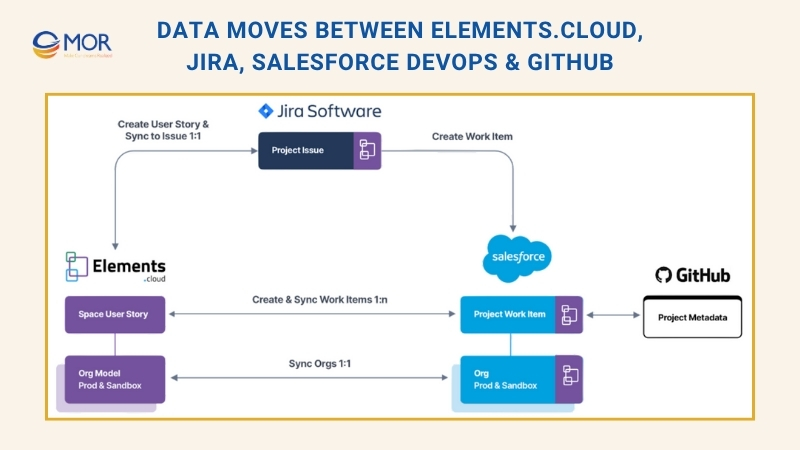
If more partners want to build their own extensions, the Elements team is open to sharing their experience, as well as the center data models and process maps that guided their development.
MOR Software: Trusted Salesforce DevOps Center Partner
At MOR Software, we help businesses unlock the full potential of Salesforce DevOps Center through hands-on implementation and customization. Our team combines strong salesforce CRM consulting expertise with deep experience in automation, integration, and cloud infrastructure to streamline every stage of the development lifecycle.
We assist clients in setting up and configuring DevOps Center, connecting it with GitHub or other repositories, and designing smooth pipelines for deployment. Beyond the technical setup, we integrate DevOps Center with collaboration tools like Jira or Slack to keep teams aligned and productive.

Our developers and consultants also train in-house Salesforce teams to manage version control, automate testing, and apply release best practices confidently. With a track record of successful Salesforce projects, including workforce management and Customer 360 solutions, we deliver scalable systems that improve release quality and reduce deployment risks.
Partner with MOR Software JSC to modernize your Salesforce operations, strengthen collaboration between admins and developers, and accelerate secure, reliable deployments.
Contact us to start your Salesforce DevOps journey.
>>> Break down key factors influencing salesforce consultant hourly rate to help your business make informed financial decisions and maximize its investment.
Conclusion
The Salesforce DevOps Center gives teams a clearer, safer, and more structured way to manage changes across Salesforce environments. It reduces confusion, improves visibility, and helps releases move faster with fewer risks. With the right setup and guidance, it becomes a strong foundation for long term growth and better teamwork. MOR Software can help you unlock its full value through expert implementation and support. Contact us to build a smarter and more reliable Salesforce release process.
MOR SOFTWARE
Frequently Asked Questions (FAQs)
What is Salesforce DevOps Center?
Salesforce DevOps Center is a built-in platform that helps teams manage releases, track changes, and collaborate more effectively. It supports both low-code and pro-code developers, allowing everyone to work together within Salesforce using modern DevOps practices like version control and automated pipelines.
What is the purpose of Salesforce DevOps Center?
The main goal of Salesforce DevOps Center is to make development, testing, and deployment easier and more transparent. It introduces a structured process where changes can be tracked, reviewed, and promoted across environments without relying on traditional change sets.
Is Salesforce DevOps Center free?
Yes. Salesforce DevOps Center is free for users on Professional, Enterprise, and Unlimited editions. There are no license fees, though teams might still need paid services like GitHub or other third-party tools for integration and automation.
How do I open Salesforce DevOps Center?
To access DevOps Center, go to your Salesforce org where it’s installed, open the App Launcher, and search for “DevOps Center.” Select your assigned project to view pipelines, work items, and deployment stages. Admins or managers can create and manage these projects.
What is DevOps in Salesforce?
Salesforce DevOps refers to the combination of tools, workflows, and cultural practices that improve collaboration between development and operations teams. The approach focuses on continuous delivery, automation, and high-quality deployments across Salesforce environments.
What are the main features of Salesforce DevOps Center?
Key features include:
- Visual pipelines for release management
- Integration with GitHub for version control
- Work items that group related changes
- Automated change tracking
- Compatibility with both low-code and pro-code workflows
How does Salesforce DevOps Center differ from change sets?
Unlike change sets, which require manual selection and deployment, DevOps Center automates the process. It integrates directly with Git for tracking and provides visual pipelines that display where each change is in the deployment process, reducing manual effort and errors.
Can beginners use Salesforce DevOps Center?
Yes. The platform is designed for both technical and non-technical users. Admins can make changes using a simple interface, while developers can still use Git and command-line tools if needed. This makes it ideal for hybrid teams with mixed skill levels.
Does Salesforce DevOps Center support GitHub integration?
Yes. GitHub integration is one of its core features. Every change made in Salesforce is tracked in Git, giving teams full visibility and a history of edits, rollbacks, and deployments. Future updates are expected to include more repository options beyond GitHub.
What are the system limitations of Salesforce DevOps Center?
Currently, it only supports GitHub as the source control system and works best for org-based development rather than Salesforce DX projects. It also lacks built-in rollback and Jira integration, though extensions can fill these gaps.
How do pipelines work in Salesforce DevOps Center?
Pipelines in DevOps Center show the path that changes take from development to production. Each stage represents an environment, like Dev, UAT, or Prod, and changes can be reviewed and promoted step by step with built-in approval controls.
Can I integrate testing tools with Salesforce DevOps Center?
Yes. You can connect third-party tools or use partner extensions from the AppExchange to run automated tests within your release pipeline. This allows for better quality assurance and reduces risks before deployment.
Rate this article
0
over 5.0 based on 0 reviews
Your rating on this news:
Name
*Email
*Write your comment
*Send your comment
1